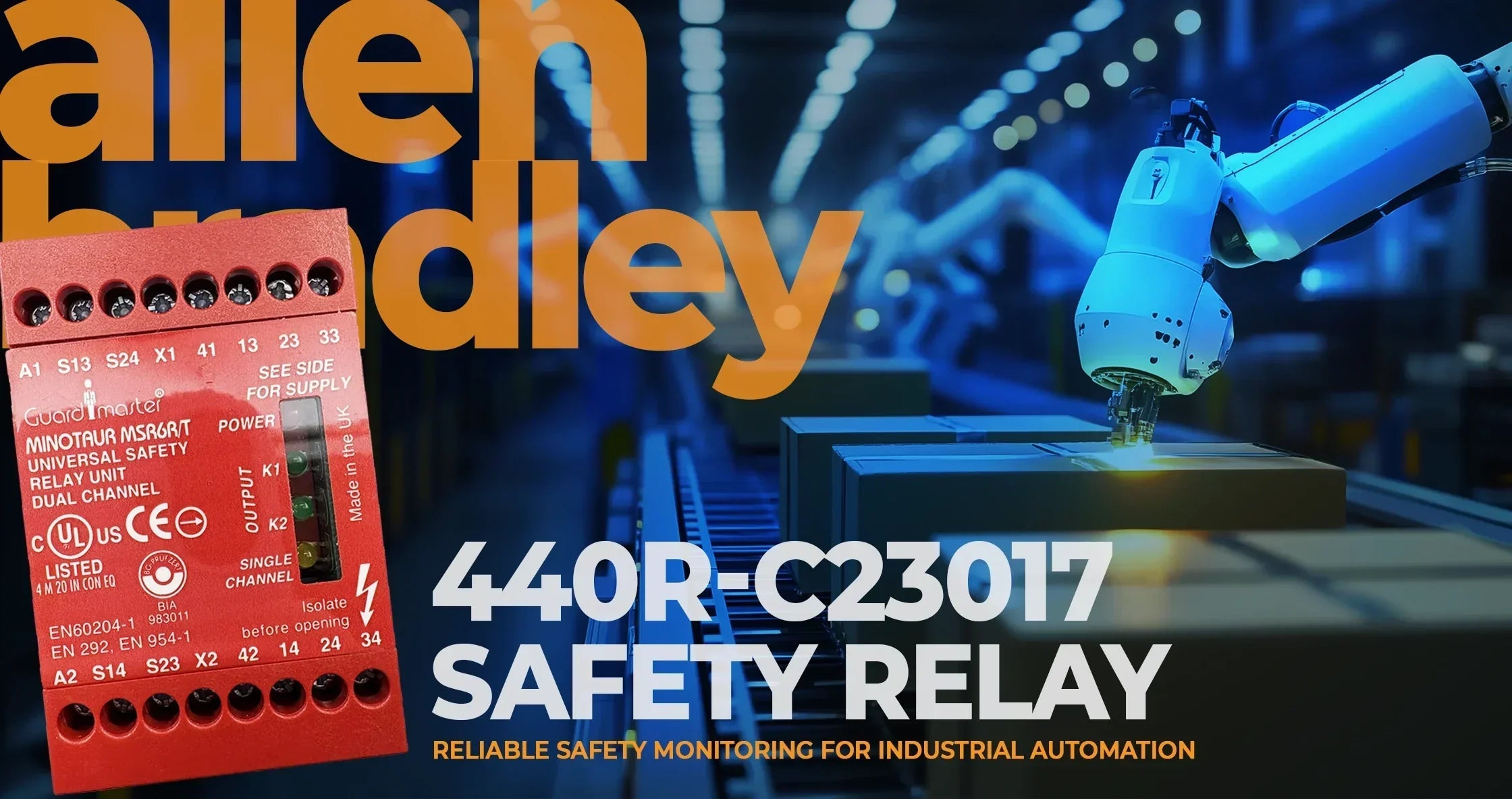In industrial automation, machine safety is non-negotiable. One of the most widely used devices to safeguard workers and ensure compliance with safety standards is the Allen-Bradley 440R-C23017 Safety Relay. This safety relay, part of Rockwell Automation’s Guardmaster Minotaur series, is designed for monitoring safety devices and reliably switching safety outputs when hazardous conditions arise.
In this blog, we will provide a comprehensive deep dive into its specifications, explain the importance of each feature, compare it with other models, and explore real-world application scenarios. By the end, you’ll see why the Allen-Bradley 440R-C23017 Safety Relay is an essential piece of equipment for manufacturers across various industries.
What is the Allen-Bradley 440R-C23017 Safety Relay?
The Allen-Bradley 440R-C23017 Safety Relay is a DIN-rail-mounted device engineered to monitor safety inputs, such as emergency stop buttons, safety gates, and interlock switches. When a fault or hazardous condition is detected, the relay interrupts the circuit and deactivates connected machinery. It is designed to operate on 24V AC or 24V DC, offering flexibility in industrial environments that use either power type.
Unlike complex programmable safety controllers, this relay provides a straightforward solution for single-function safety monitoring. With selectable reset modes and auxiliary feedback contacts, it strikes a balance between safety, simplicity, and diagnostic capability.
Key Specifications of the Allen-Bradley 440R-C23017 Safety Relay
Below is a comprehensive breakdown of the Allen-Bradley 440R-C23017 Safety Relay specifications:
● Supply Voltage: 24V AC/DC
● Safety Inputs: 1 Normally Closed (N.C.) or 2 N.C. selectable
● Additional Inputs: 3 Normally Open (N.O.) contacts
● Safety Output: 1 N.C. contact
● Auxiliary Contact: 24V AC/DC rated
● Reset Options: Automatic, Manual, or Monitored Manual
● Mounting: DIN Rail with removable terminals
● Indicators: LED diagnostics for power and status
These specifications ensure the device can be easily integrated into a wide range of safety circuits, from simple emergency stop functions to more advanced interlocking systems.
Why Input Options Matter
The Allen-Bradley 440R-C23017 Safety Relay allows users to configure either a single-channel (1 N.C.) or dual-channel (2 N.C.) input configuration.
● Single-channel (1 N.C.): Suitable for less complex systems with lower safety requirements. It simplifies wiring but provides less redundancy.
● Dual-channel (2 N.C.): Offers redundancy by requiring two safety channels to be activated. This ensures that if one channel fails, the other can still maintain system integrity.
The three additional N.O. contacts enable further logic controls, such as machine readiness or external enabling conditions.
Safety Outputs and Auxiliary Contact
The device features a 1 N.C. safety output to disconnect hazardous energy sources during faults. This contact ensures that power to motors, actuators, or contactors is removed under unsafe conditions.
The auxiliary contact provides a status signal for system monitoring. It allows feedback to be sent to a PLC or control system, enabling operators to see whether the relay is energized or in a safe state.
Reset Modes Explained
Reset functionality is a crucial feature in safety relays. The Allen-Bradley 440R-C23017 Safety Relay offers three reset options:
- Automatic Reset – Restores outputs as soon as safe conditions are reestablished.
- Manual Reset – Requires operator input before outputs are restored, preventing automatic restarts.
- Monitored Manual Reset – Adds extra diagnostics by verifying the integrity of reset circuits and buttons.
This flexibility ensures the relay can be configured to match the risk assessment of the machine or process.
Technical Advantages of the Allen-Bradley 440R-C23017 Safety Relay
The Allen-Bradley 440R-C23017 Safety Relay provides several key benefits:
● Compact DIN Rail Design: Saves control panel space.
● Flexible Input Options: Adaptable to different safety categories.
● International Compliance: Supports compliance with ISO 13849 (Performance Levels).
● Built-In Diagnostics: LED indicators and auxiliary feedback simplify troubleshooting.
● Proven Reliability: Guardmaster relays are widely recognized for durability in industrial environments.
Wiring and Integration Guide
When integrating the Allen-Bradley 440R-C23017 Safety Relay, the wiring depends on the chosen reset mode and input configuration.
● Emergency Stop Wiring (Dual-Channel): Two N.C. E-stop contacts wired into the dual-channel inputs. This ensures both circuits must be intact for the relay to operate.
● Guard Door Interlock Wiring: Interlock switches wired to the safety inputs. When a guard door opens, the relay deactivates the safety output.
● Reset Circuit Wiring: For manual or monitored reset, a push button wired into the N.O. input is required.
Clear wiring diagrams are provided in the datasheet to guide installation and prevent miswiring.
Application Examples in Industry
The Allen-Bradley 440R-C23017 Safety Relay is used across a wide range of applications:
Emergency Stop Circuits
Factories often require emergency stop systems on conveyors, robotic arms, and production lines. This relay ensures machines halt immediately when an operator presses the E-stop button.
Guard Door Interlock Monitoring
Packaging and machining systems with guarded doors rely on safety relays to prevent operation when doors are open. The relay ensures operators are not exposed to moving machinery.
Light Curtains and Presence Sensors
For applications requiring two-channel safety inputs, the relay monitors devices like light curtains. If a person breaks the beam, the safety relay immediately interrupts hazardous energy.
Material Handling Systems
Conveyors and material handling systems use safety relays to monitor multiple interlocks. This prevents collisions, jams, or unsafe access to moving belts.
Machine Tools and CNC Equipment
High-speed CNC machines benefit from relays like the Allen-Bradley 440R-C23017 Safety Relay to shut down spindle motors in the event of operator access to the work area.
Comparison with Other Allen-Bradley Safety Relays
To help you understand where the Allen-Bradley 440R-C23017 Safety Relay fits within the product family, here’s a quick comparison with other models:
|
Model |
Supply Voltage |
Inputs |
Outputs |
Reset Modes |
Application Scope |
|
440R-C23017 |
24V AC/DC |
1 or 2 N.C., 3 N.O. |
1 N.C. safety, 1 aux |
Auto, Manual, Monitored Manual |
General safety monitoring |
|
440R-C23271 |
24V DC only |
2 N.C. |
3 N.O. safety, 1 N.C. aux |
Auto/Manual |
Advanced dual-channel devices |
|
440R-D22R2 |
24V DC |
2 N.C. |
2 N.O. safety, 1 N.C. aux |
Configurable |
More complex safety tasks |
This table shows that the 440R-C23017 is best suited for straightforward monitoring, while other models may provide additional safety outputs or more complex configurations.
Compliance with Safety Standards
Safety relays like the Allen-Bradley 440R-C23017 Safety Relay are crucial for compliance with standards such as:
● ISO 13849-1 – Performance Levels for safety-related parts of control systems.
● IEC 61508 – Safety Integrity Levels (SIL) for functional safety.
● IEC 60204-1 – Safety of electrical equipment of machines.
By integrating this relay, machine builders can ensure their equipment meets global safety requirements and provides operators with reliable protection.
Extended Case Study: Automotive Manufacturing
In an automotive assembly line, operators frequently interact with robotic welding cells. The Allen-Bradley 440R-C23017 Safety Relay is commonly wired to interlock switches on cell gates. When a gate is opened, the relay cuts power to welding robots and associated machinery. Auxiliary contacts feed back to the plant’s PLC, logging the safety stop and ensuring no restart occurs until the system is reset safely.
This case highlights how the relay contributes to both worker safety and production accountability.
Limitations of the Allen-Bradley 440R-C23017 Safety Relay
While the relay provides robust safety functions, there are limitations to consider:
● Single Safety Output: Limits direct control of multiple actuators without additional contactors.
● Not Programmable: Cannot handle complex safety logic beyond fixed input/output monitoring.
● Obsolescence: Some Minotaur series relays have been discontinued; check availability before large-scale adoption.
For more complex applications, Rockwell’s modular safety controllers or safety PLCs may be better suited.
Conclusion: A Dependable Choice for Safety Monitoring
The Allen-Bradley 440R-C23017 Safety Relay is a dependable solution for machine safety. With flexible input options, selectable reset modes, and auxiliary contacts, it meets the needs of diverse industrial applications. From emergency stop circuits to guard door monitoring, this safety relay ensures both compliance and worker protection.
For engineers seeking a compact, reliable, and standards-compliant safety relay, the Allen-Bradley 440R-C23017 Safety Relay delivers practical functionality. To explore integration or purchase options, visit the official product page and see how this relay can enhance your safety systems.
🔗 Explore Related Product Collections
If you’re interested in the Allen-Bradley 440R-C23017 Safety Relay, you may also want to explore related collections that complement your safety and control systems:
A dedicated collection of safety relays, including Allen-Bradley Guardmaster models and equivalent products for a wide range of machine safety applications.
This collection goes beyond safety relays to include control relays and interlocks, ideal for building more complex machine protection and monitoring systems.
Control Relays – Motor Control Equipment →
Essential relays for motor control applications, providing dependable switching and integration with safety circuits.


